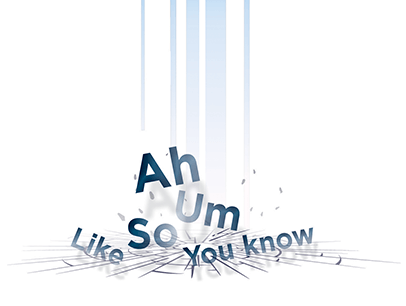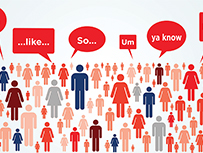
Many people use filler words and phrases in everyday conversations and public speaking. Why does Toastmasters emphasize reducing this habit? Because the crutch words add no meaning to a speaker’s message. When used frequently and excessively, filler words bring negative effects: They reduce the speaker’s credibility and distract the audience from the main points of the speech.
Filler words can take many forms, including sounds (um, uh, ah, er, hm), words (like, well, okay, so, basically, really, very), and phrases (you know, you see, you know what I mean, to be honest with you, in fact).
People use these filler words for a variety of reasons: to buy time while figuring out what to say next, to hesitate due to uncertainty or lack of confidence, to make statements sound less direct, and to signal a shift or introduction of a new idea. People may also develop a habit of using their go-to filler words repeatedly and unconsciously.
Speakers are often unaware of how frequently they use crutch words, but listeners tend to notice and get distracted. Luckily, it isn’t difficult to learn to omit these words or replace them with more purposeful strategies. Here are several strategies to help reduce their use.
Before the Speech
- Plan your speech.
A formal speech should include a clear beginning, middle, and end. For example, you could start with an engaging introduction, such as a hook question, to capture the audience’s attention. Then, include several key points, each supported by evidence or examples. Finally, conclude with a summary and a clear take-home message. When your speech is well planned and organized, you’re less likely to search for your thoughts while speaking, resulting in fewer filler words. - Practice your speech.
Rehearse your speech thoroughly if it is a prepared one. To help you memorize and internalize your speech, try breaking it into multiple sections to understand its logic and structure. If a particular section is challenging, revise or rehearse it until you feel comfortable saying it without using any crutch words. Write out your speech to reinforce memory, and practice in front of a mirror or with family and friends.
During the Speech
- Manage your pace.
When you’re delivering a speech, keep in mind the structure and major sections of your content. Slow down to give yourself more time to think, especially when transitioning from one point to the next. Whether it’s a formal speech or an informal conversation, slowing down allows you to listen to yourself and make a conscious effort to reduce filler words. Your audience will also appreciate a slower pace, as it gives them time to process the information. - Incorporate pauses.
Use pauses instead of filling the silence with unnecessary words. Pausing not only helps eliminate fillers but also draws your audience’s attention to the next point, increases their interest, and gives them time to understand what you’re saying.
After the Speech
- Identify filler words.
Recording your speech can help you analyze your speaking habits and identify the filler words you tend to use. Many digital tools like Zoom can generate a transcript automatically for you to review. You can use the search function in the transcript to count how often each filler word appears. Some artificial intelligence powered software can even count filler words for you.When reviewing your transcript, a useful way to identify fillers is to compare a sentence with and without the word. If the sentence remains clear without it, then it’s likely a filler word.
- Example: In the sentence “I like to run every day,” “like” is not a filler word. But in the sentence “I, like, run every day,” “like” serves no purpose and is considered a filler word.
- Review feedback from your Toastmasters club.
The Ah-Counter in a Toastmasters club usually tracks and tallies each speaker’s filler words, and sometimes even offers real-time reminders when a crutch word is used (e.g., ringing a bell). Reviewing the Ah-Counter’s report after each of your speeches can help you identify your frequently used filler words and monitor your progress over time. Your speech evaluator might also note whether you used filler words.
With efforts before, during, and after your speech, you can significantly reduce your use of filler words. Doing so will make your speech more articulate, concise, and impactful—whether in public speaking or everyday conversations. Let’s fill our speech with substance!
Yue Yin is a professor of educational psychology at the University of Illinois Chicago. She is a member of the Toastmasters at Purdue club in West Lafayette, Indiana, and can be reached at yueyin@uic.edu.



 Previous
Previous

 Previous Article
Previous Article

